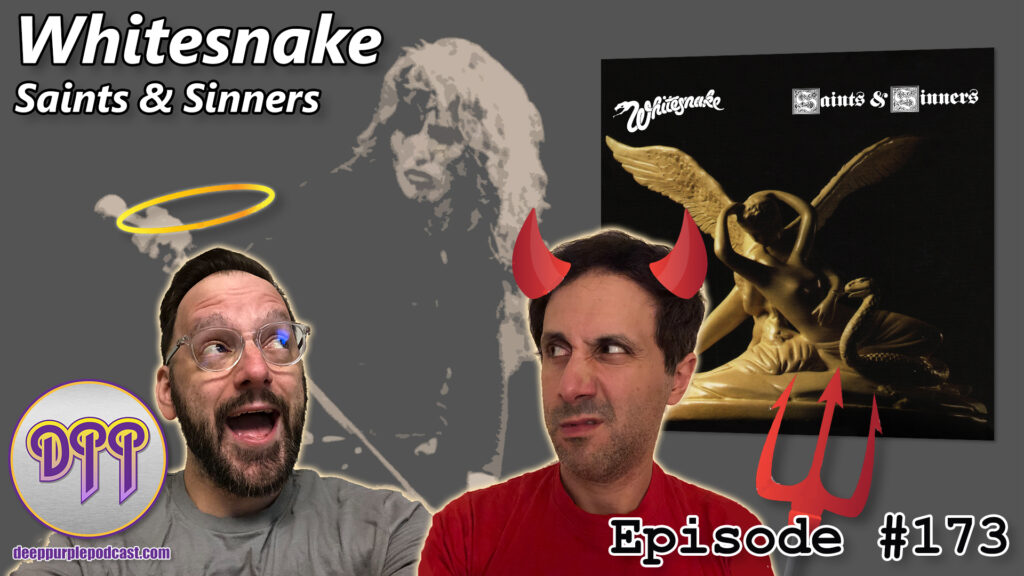
Subscribe at Apple Podcasts, Stitcher, Google Podcasts, Overcast, Pocket Casts, Anchor.fm, Breaker, PodBean, RadioPublic, Amazon Music, or search in your favorite podcatcher!
How To Support Our Show:
- Leave us a 5-Star Review on Apple Podcasts
- Buy Merch at Our Etsy Store!
- Become a Patron on Patreon
- Donate on Paypal (Donate one time or click “make this a monthly donation” box)
- Donate to $DPPOD Using Cash App
Brendan Ashbrook – Logo Designer
Thanks to Our Executive Level Patrons:
- The $25 “Uncommon Man” Tier
- Ovais Naqvi
- $15 “What’s Goin’ On Here” Tier
- Richard Fusey
- The £10 Tier
- Dr. Jill Breis
- The Turn it up to $11 Tier
- Clay Wombacher
- Frank Theilgaard-Mortensen
- Alan “Ain’t Too Proud To” Begg
- Mikkel Steen
- $10 “Some One Came” Tier
- Ryan M
- Jeff Breis
- Victor Campos
- “Better Call” Saul Evans
- Kev Roberts & his wonderful children: Matthew, Gareth, and Sarah
A Word From Our Sponsor:
- Budweiser
Whitesnake Live in Illinois September 1, 2022!
- https://whitesnake.com/event/rosemont-il-2022/
- Live at Allstate Arena in Rosemont, IL
- With Scorpions
Hall of Fame Presentation:
Deep Dive Podcast Network:
- Deep Dive Podcast Network
- Sabbath Bloody Podcast
- Skynyrd Reconsydyrd
- The Deep Purple Podcast
- T-Bone’s Prime Cuts On The Other Side
- In The Lap Of The Pods
- The Magician’s Podcast
- Hawk Binge
- Maiden A-Z
- Diary of the Madmen
- Universally Speaking: The Red Hot Chili Peppers Podcast
- Metal Gods Podcast
- The Podcast Will Rock
- Back Tracks: Aerosmith Revisited
- So Far, So Pod . . . So What!
- The Tom Petty Project
Lead up to the Album:
- In December of 1981 Micky Moody quit Whitesnake.
- Moody: “By ’81 people were becoming tired. We had too many late nights, too much partying. We weren’t making nowhere near the kind of money we should have been making. Whitesnake always seemed to be in debt, and I thought “what is this?, we’re playing in some of the biggest places and we’re still being told we’re in debt, where is all the money going?”. We hadn’t got much money out of it and to be told you’re 200,000 pounds in debt, when you just had six golden albums. It wasn’t just me, cause everybody was getting tired, pissed off and losing their sense of identity. It was over by then, we couldn’t get any further. It’s difficult for a band to go more than three or four years without getting tired of each other and losing ideas. Nothing lasts forever. Everybody wanted to do something different after a few years, a solo album or write with someone else.”
- Soon after Moody quit David Coverdale called a meeting put the band on hold. He used this opportunity to break ties with long time Deep Purple and Whitesnake manager John Coletta. From that point on Coverdale took over the business end of the band.
- In 1982 Marsden quit the band as well. In Marsden’s book he states that David Coverdale called a meeting and dismissed the remaining members of the band with the exception of Jon Lord.
- In August of 1982 David Coverdale tried to get Micky Moody to return to the band to complete the album. Along with new guitarist Mel Galley they finished up backing tracks. Birch was there for final production and mixing.
- Marsden states in his autobiography: “How could it all go so wrong? The answer lay not so much in what we were doing as what we weren’t. We were no longer working with the seventh member of the band, its heart – one Martin Birch. He was the glue that held Whitesnake together. With hindsigh, it’s bloody easy to see. Martin was not there from the start of the album sessions and so, MArtin Birch, it was all your fault!”
- Marsden goes on to say that Birch was producing Rainbow and also Iron Maiden which was taking up much more of his time and likely because Iron Maiden was paying him more than Whitesnake’s label was willing to. Marsden: “. . . when we were informed that Martin would not be producing us any more, not one of us asked any questions, and shame on us all for that. We should have asked why, and we should have demanded answers.”
- They got together at Nomis Studios in west London to work on the album with Guy Bidmead who’s worked with Marsden on his solo album.
- Marsden says he and David had written new material but that Moody hadn’s seemed interested in writing any new songs.
- Marsden describes this album as the beginning of the end.
- They went on to record at a studio called Rock City which Marsden says none of them liked. He described the studio as being technically fine but lacking the high-end perks of previous sessions and that none of the band felt at home.
- Shortly after they left Rock City and moved to Clearwell Castle in Gloucestershire. Marsden said that after that move the vibe was back.
- The album was mixed at Britannia Row where Marsden did some guitar overdubs.
- Marsden describes two sessions where Jon and Ian were both no shows. He then suggested they end the band and David told him it was already int eh worlds.
- There was an attempt to fire their label, Seabreeze, to which Coverdale didn’ts how up.
- Marsden says that Coletta gathered with Lord, Paice, Murray, and Marsden tot ell thema lll he was out of the band.
- Marsden says after they all left he pulled Marsden aside and told him he’d been offered to sign him as a solo artist but that he had to sign the contract that day.
- He said the band ended without any sort of fight or anything, it just sort of fizzled out.
- After this the album was finished without all of the ordiginal contributors to the songwriting or recording.
- In Moody’s book he mentions taht the manager of Clearwell Castle, Bernard Yeates, told them that he’d booked a wedding reception during the sessions and that the bride’s parents had been warned taht there would be a rock band hanging out at the bar and the common areas.
- Moody tells a story of Billy Connolly and his then girlfriend Pamela Stephenson being wedding guests and they ended up partying with them at the wedding indulging in “a combination of toot and booze.” Connelly picked up Moody’s banjo and began playing it.
Core Band:
- David Coverdale – lead vocals
- Micky Moody – guitar, backing vocals
- Bernie Marsden – guitar
- Neil Murray – bass
- Ian Paice – drums, percussion
- Jon Lord – keyboards
- Backing Vocals – The Paratroopers (2)
- Backing Vocals [“The Paratroopers”] – D. C.*, Mel Galley, Micky Moody
Includes printed inner sleeve (with a thumb cut) and merchandise insert.
The backing trax were recorded at Rock City, Shepperton; The Truck Mobile at Clearwell Castle, Gloucestershire and Brittania Row, London.
The vocal trax were recorded at Battery Studios, London.
Mixed at Battery Studios Sept/Oct 1982.
Runouts:
‘ƱtopiA’ / ‘ƱTOPIA’ / ‘Ʊtopia’, ‘THE GAY BLADE STRIKES AGAIN…’ and ‘WE WISH YOU WELL…’ are etched; remainder is stamped.
‘Ʊ’ in runouts represents the Utopia Studios lyre symbol.
Variant 8 – the ‘U’ of Side A’s 30354 A-6U̶-1-1-1′ is crossed out with ‘x’
Technical:
- Recorded By [Backing Trax] – Guy Bidmead
- Recorded By [Vocal Trax, Assistant] – Bryan New*
- Recorded By [Vocal Trax], Mixed By, Producer – Martin Birch
- Mastered By – Steve Angel
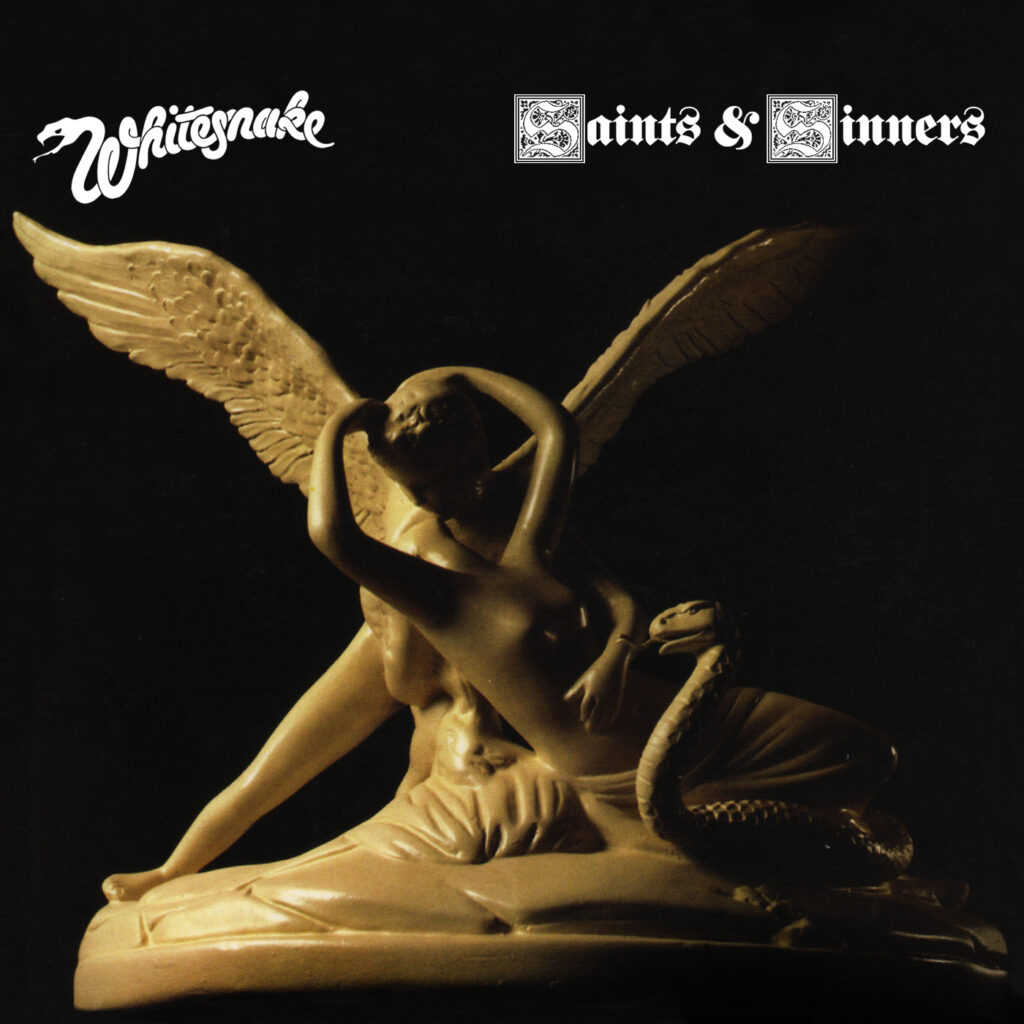
Album Art & Booklet Review
- Design [Cover] – The Concert Publishing Company
- Photography By [Back Cover] – Virginia Turbett
- The back cover features a picture of David Coverdale alone and full band credits were left off the album amidst the turmoil the band’s lineup was going through at the time.
- Critical reception of the album cover was not good. Simon Robinson describe it as, “a kitschy sculpture of the kind some folk insist on decorating their mantlepieces with.”

- Sculpture seems to be based on the sculpture Psyche Revived by Cupid’s Kiss by Antonio Canova who also had a painting.

- This sculpture was inspired by a Roman painting found in Herculaneum during Canova’s visit to Naples in 1787.
- Canova also seems to have an oil painting based on this as well.
Thanks to Our Core Level Patrons:
- The $7.77 KeepItWarmRat Tier
- Michael Vader
- The Episode $6.66 Tier
- Steve Coldwell
- Arthur Smith
- Anton Glaving
- The $6.65 “Almost Evil” Tier
- Kenny Wymore
- $5.99 The “Nice Price” Tier
- Fielding Fowler
- Robert Smith
- Peter from Illinois
- Michael Bagford
- Karl Hellberg
- $5 “Money Lender” Tier
- John Convery
- German Heindl
- Adrian Hernandez
- Jesper Almén
- Oleksiy The Perfect Stranger Slyepukhov
- James North
- Mark Hodgetts
- Will Porter
- Zwopper The Electric Alchemist
- Tim “Southern Cross” Johnson
- Percival Frequency
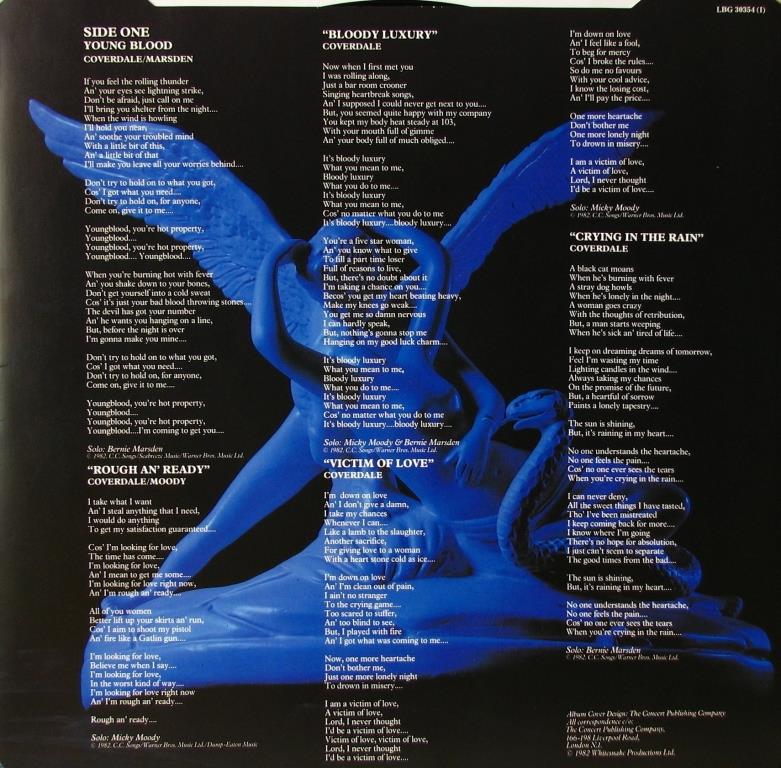
Album Tracks:
Side One:
- Young Blood (Coverdale, Marsden)
- Solo: Marsden
- Rough An’ Ready (Coverdale, Moody)
- Solo: Moody
- Bloody Luxury (Coverdale, Marsden, Moody)
- Solo: Marsden, Moody
- Victim of Love (Coverdale, Moody)
- Solo: Moody
- Moody put this solo down after being rushed back into the studio along with Mel Galley to do backing vocals.
- Crying In The Rain (Coverdale, Marsden)
- Solo: Marsden
- The song was written about the breakup of Coverdale’s first marriage, written in Portugal.
- Marsden describes this as a great new song that was “drenched int he irresistible humour that was Whitesnake at the time.”
- They had seen a TV news report interviewing about a local man about the mass extermination of farm animals int he area. The news reporter seemed very serious about the death of the animals and the local man said “Plenty more about.” They said the band cracked up at the man’s response.
- He said that at the point of the song where David is supposed to sing “black cat moans when he’s buringn with a fever,” David instead did an imitation of the man and said, “Plenty more about!”
- Marsden said they were laughing too heard and the session was almost ruined. They had to take a break for an hour and ban Coverdale from the studio until they finished the track.
- Marsden says there’s a tape of this take and he still thinks it’s hilarious.

Side Two:
- Here I Go Again (Coverdale, Marsden)
- Solo: Marsden
- Marsden said he recorded a demo of this and played it for Jon Lord who asked him to play the opening chords again. When he heard them he said to Bernie, “You’re a clever little sod, aren’t you?”
- Marsden said Lord loved playing the opening on the Hammond.
- He said Coverdale went into “lyrical overdrive” after hearing the demo. He said Coverdale wrote new lyrics to it.
- Neil, Jon, Ian, and Bernie are all on backing vocals.’
- Marsden said that the guitar solo has a nod to John Lennon’s “Woman” in the arepeggio.
- Marsden said he thought they had a big song on their hands with this one as did David but, clearly, neither of them realized how big it would become.
- Coverdale says he also wrote this in Portugal about the breakup of his first marriage.
- Love An’ Affection (Coverdale, Moody
- Solo: Lord
- Rock An’ Roll Angels (Coverdale, Moody)
- Solo: Lord
- Marsden said for reasons that he couldn’t explain that Paice struggled with this song and had to redo it several times. He said it was very unlike Ian and that Ian was very short on confidence at this point, which he also says was uncharacteristic.
- After about ten takes Ian sent the band to the pub so he could record it alone with Guy.
- Dancing Girls (Coverdale)
- Solo: Lord
- Saints An’ Sinners (Whitesnake)
- Solo: Marsden
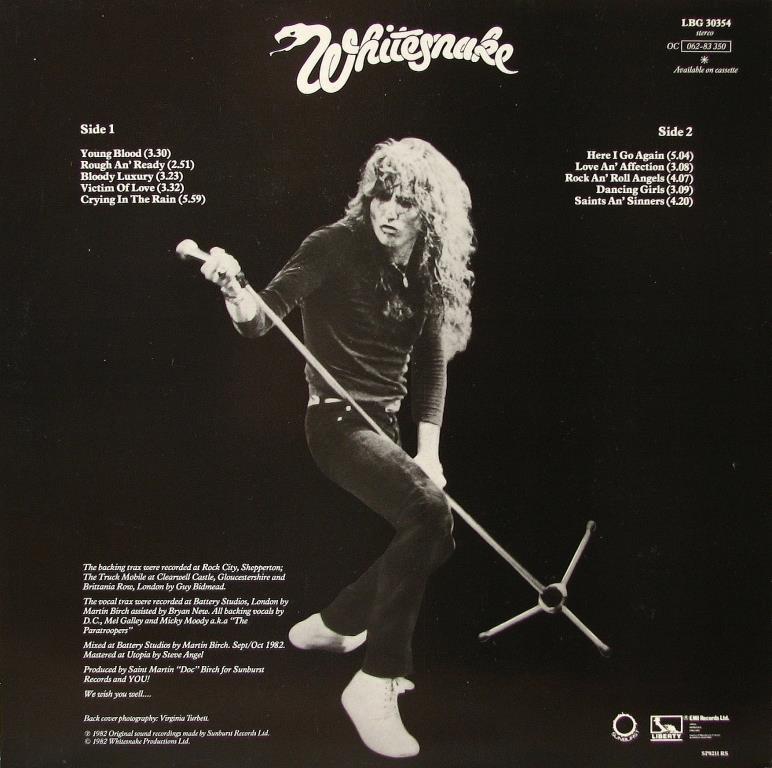
Thanks To Our Foundation Level Patrons:
- The $3.33 Half Way to Evil Tier
- Raff Kaff
- $3 “Nobody’s Perfect” Tier
- Peter Gardow
- Ian Desrosiers
- Mark Roback
- Duncan Leask
- Stuart McCord
- Flight of the Rat Bat Blue Light
- Øyvind Fjeldbu –
- Runar Simonsen –
- JJ Stannard
- $1 Made Up Name Tier
- The “Man Who’s Oozing with the Rock and Roll Angels” Leaky Mausoleum
- Stephen Sommerville The Concerto 1999 Fanatic
- Spike, The Rock Cat
- Hank the Tank
- Private Eyes
- Ashen Lionel
- Spike’s Mom
- Blackmore’s Tights
- John Miceli
Bustin’ Out The Spreadsheet
Reception and Charts:
- The album peaked at number 9 on the UK Album Charts.
- It’s said that Coverdale released this album “as is” based on time constraints and contractual obligations.
- Micky Moody described the album’s songs: “the songs went form the sublime (‘Here I Go Again’ and ‘Crying in the Rain’) tot he ridiculous (‘Bloody Luxury’ and ‘Dancing Girls’), with a bunch of well-performed albeit unremarkable – rockers hovering about in the middle.
- They embarked on a tour after recording but it had to be canceled due to Ian Paice coming down with mumps.
- Coverdale: “Well, there are some good songs. I mean there are always good songs on my stuff. I’m a song guy. But it was definitely a jigsaw puzzle of a record.”
- Coverdale said he was really torn and didn’t know what to do to get out of his management deal. He said when his daughter was 4 or 5 that she had a really tough time with some illnesses and when he was really worried about her and praying for her recovery he said it gave him “the balls to turn around and say, ‘This means nothing to me; I want out.’ That was how he reformed the band and got out of his bad record deal.
- Lord admitted that he didn’t think Ian Paice was very happy in the band.
Reviews:
- Simon Robinson: “Today the album remains one of their weakest, although it does hint at the transition from the traditional Whitesnake style toward the harder musical approach which was slowly emerging, especially on tracks like ‘Victim Of Love.’ Overall the sound is poor and not particularly well mixed, with the keyboards lost and the bass relegated to some far distant place.
- Jon Lord: “It’s not my job to sit here and make excuses, but . . .. the backing tracks were made under quite difficult circumstances in terms of the band itself and the producer . . . we went through about 19 different studios. It had to be released though, otherwise we would have been sued from here to Christmas.”
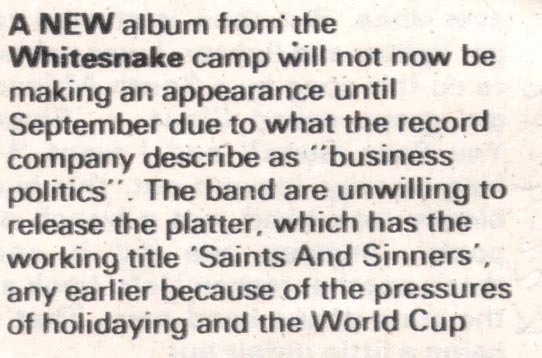
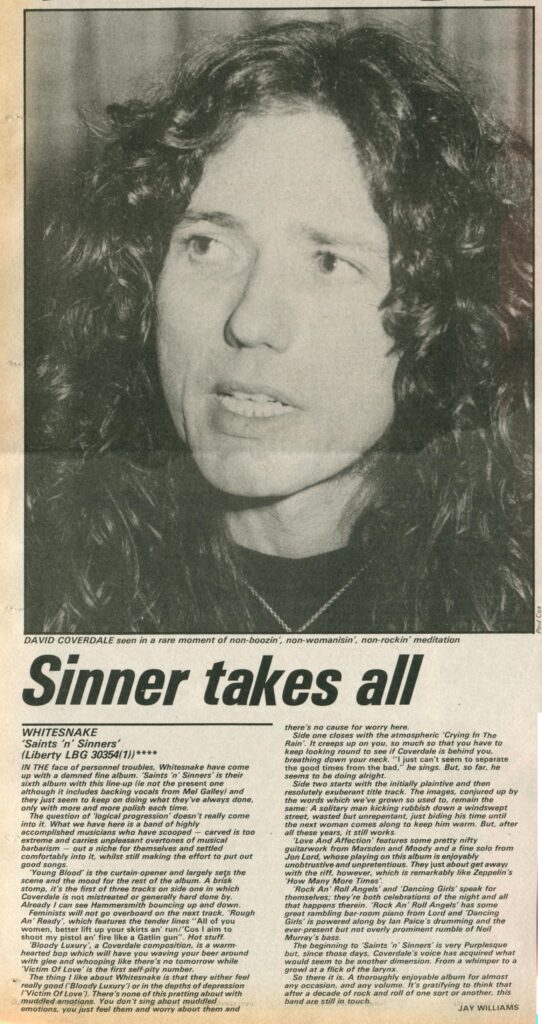

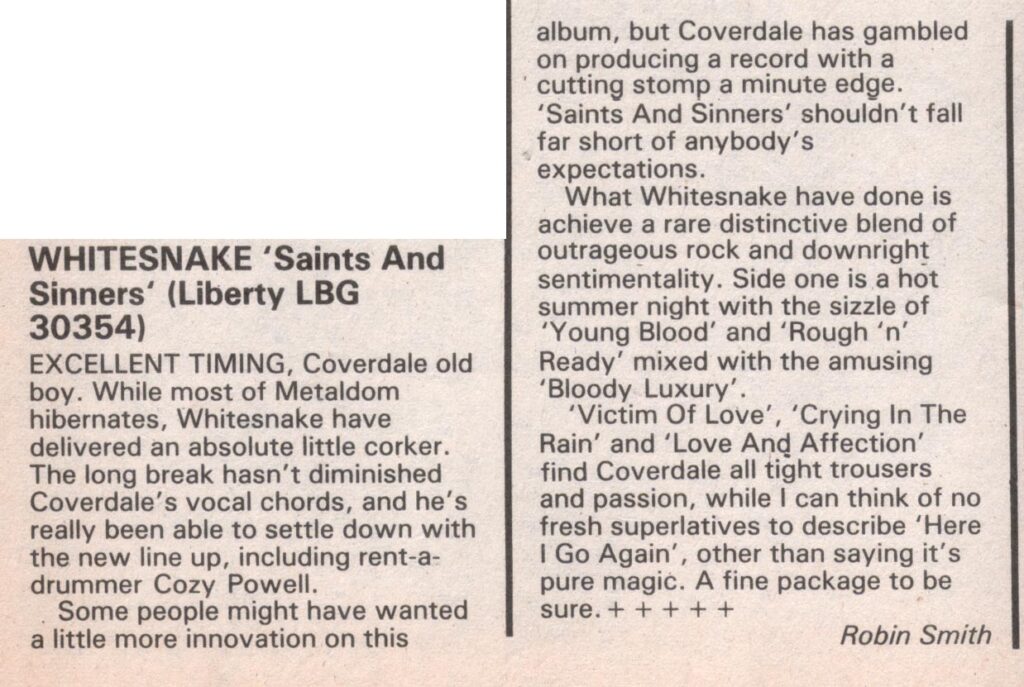
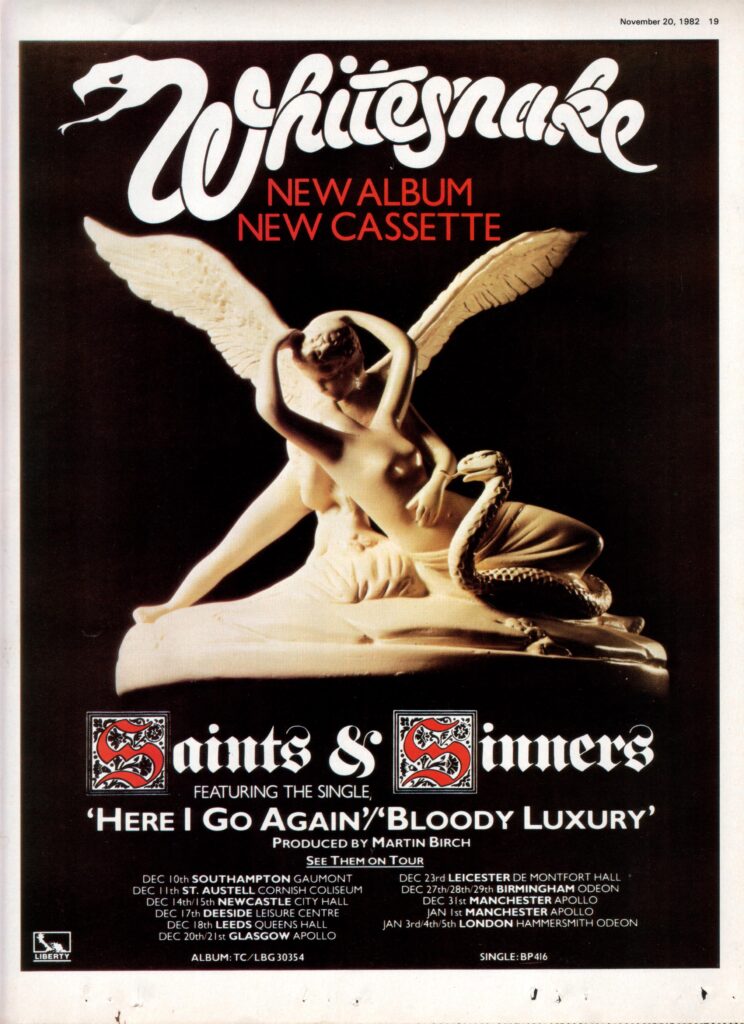


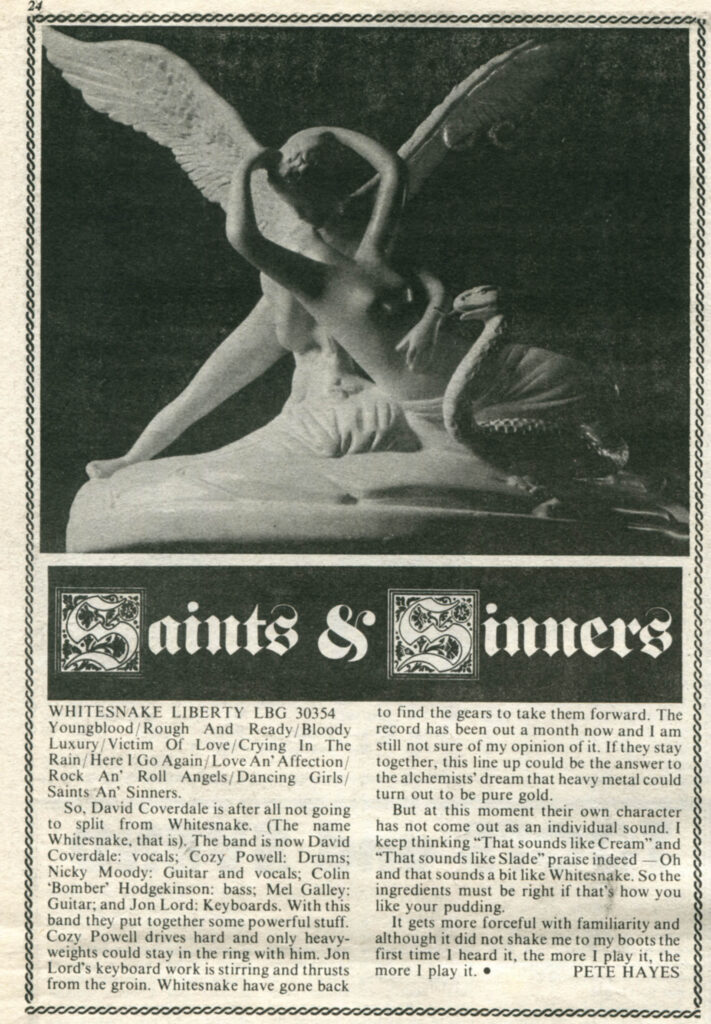

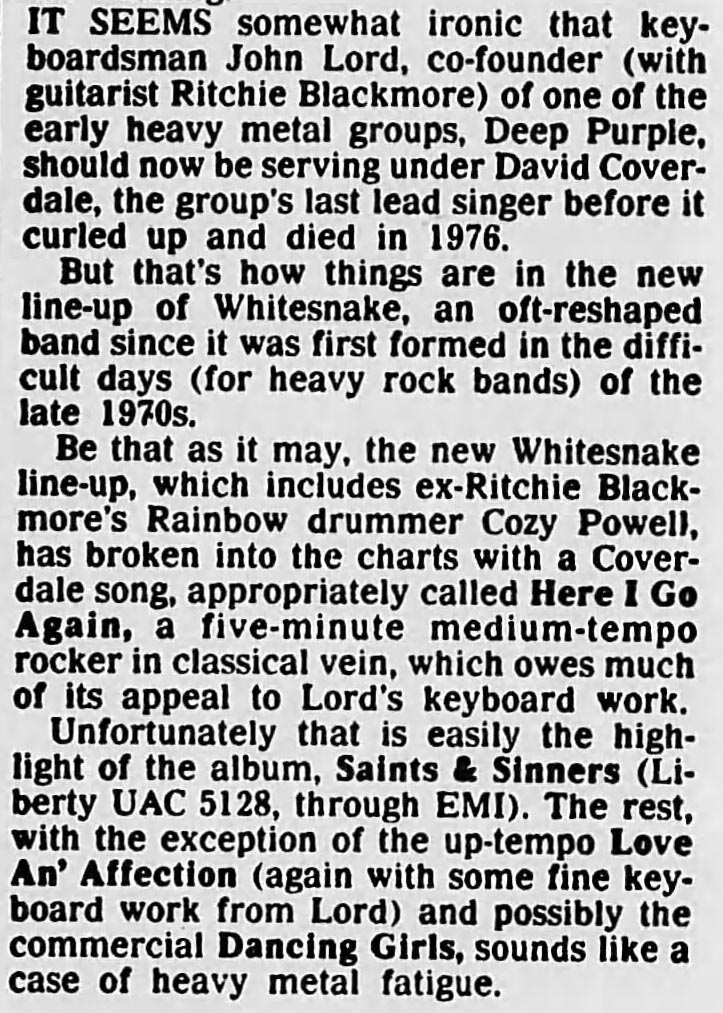
For Further Information:
- https://en.wikipedia.org/wiki/Saints_%26_Sinners_(Whitesnake_album)
- https://www.discogs.com/release/1641977-Whitesnake-Saints-Sinners
- Help from the archives of Jörg Planer
- Help from the archives of Jeff Breis
- Sail Away: Whitesnake’s Fantastic Voyage by Martin Popoff
- Where’s My Guitar by Bernie Marsden
- Whitesnake: An Illustrated Biography by Simon Robinson
- Micky Moody: Snakes and Ladders: My Autobiography by Micky Moody
- Deep Purple by Peirfrancesco Atzori
- https://artsandculture.google.com/asset/amore-e-psiche-antonio-canova/VQH6qcg_CSzVIw
- https://www.theartpostblog.com/en/psyche-revived-by-cupids-kiss-canova/
- https://www.antoniocanova.org/psyche-revived-by-cupids-kiss/
Listener Mail/Comments
- Comments about the show? Things you’d like us to cover? We’d love to hear from you. Send us an email at info@deeppurplepodcast.com or @ us on Twitter, Facebook, or Instagram.
